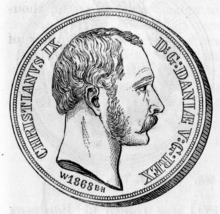- Danish rigsdaler
-
The rigsdaler (sometimes referred to as "rix-dollar"[1]) was the name of several currencies used in Denmark until 1873. The similarly named Reichsthaler, riksdaler and rijksdaalder were used in Germany and Austria-Hungary, Sweden and the Netherlands, respectively.
Contents
History
The Danish currency system established in 1625 consisted of 12 penning = 1 skilling, 16 skilling = 1 mark, 6 mark = 1 rigsdaler and 8 mark = 1 krone.[1] From 1713, two separate systems coexisted, courant and species, with courant being a debased currency also used for banknote issue. The rigsdaler species contained 4⁄37 of a Cologne mark of fine silver (i.e., 9¼ rigsdaler species equalled one Cologne mark).
In 1813, following a financial crisis, a new currency system was introduced, based on the rigsbankdaler. This was divided into 96 rigsbank skilling and was equal to half a rigsdaler species or 6 rigsdaler courant.
A further change was made in 1854. The rigsdaler species name disappeared and the names rigsbankdaler and rigsbank skilling became rigsdaler and skilling rigsmønt. Thus, there were 96 skilling rigsmønt to the rigsdaler.
In 1873, Denmark and Sweden formed the Scandinavian Monetary Union and the rigsdaler was replaced by the Danish krone. An equal valued krone/krona of the monetary union replaced the three currencies at the rate of 1 krone/krona = ½ Danish rigsdaler = ¼ Norwegian speciedaler = 1 Swedish riksdaler. Today, a tokrone (coin worth 2 kroner) is thus occasionally referred to as a daler.
Coins
In the late 18th century, coins were issued in denominations of ½, 1, 2, 4, 8, 24 and 32 skilling, 1⁄15, ¼, ⅓, ½ and 1 rigsdaler specie.
Between 1813 and 1815, copper coins bearing the legend "rigsbanktegn" ("rigsbank token") were issued in denominations of 2, 3, 4, 6, 12 and 16 skilling. From 1818, 1, 2 and 32 rigsbank skilling coins were issued, with 1 rigsdaler species from 1820. From 1826, gold coins were issued denominated in "Frederiks d'Or" or "Christians d'Or" (depending on the name of the ruling king). The "d'or" was nominally worth 10 rigsdaler, although the currency was on a silver standard. In 1838, ½ rigsbank skilling coins were introduced.
Between 1840 and 1843, a new coinage was introduced, consisting of 1⁄5, ½, 1, 2, 3, 4, 8, 16 and 32 rigsbank skilling, 1 rigsbankdaler and 1 rigsdaler species. Denominations between 4 rigsbank skilling and 1 rigsbankdaler were also inscribed with the denomination in the currency of Schleswig-Holstein, the Schilling Courant, of which there were 60 to the Speciethaler, equal to the rigsdaler species. These denominations were 1¼, 2½, 5, 10 and 30 Schilling Courant.
The renaming of the currency units in 1854 lead to the issuing of coins for ½, 1, 4 and 16 skilling rigsmønt, 1 and 2 rigsdaler. Gold "d'or" coins continued to be issued (see above).
Banknotes
In 1713, the government introduced notes for 1, 2 and 3 mark, 1, 5, 10, 25, 50 and 100 rigsdaler. The Copenhagen Assignation, Exchange and Loans Bank issued notes between 1737 and 1804 for 10, 20, 30, 40, 50 and 100 rigsdaler courant. Between 1791 and 1797, the Danish-Norwegian Specie Bank issued notes for 4, 8, 20, 40 and 80 rigsdaler specie. The treasury issued notes for 2 and 20 rigsdaler courant in 1808, followed by 8, 12 and 24 skilling notes in 1809-1810.
In 1813, the Rigsbank introduced notes in denominations of 1, 5, 10, 50 and 100 rigsbankdaler. These were followed, in 1819, by notes of the National Bank in the same denominations. After the change in name of the currency, the National Bank issued notes for 5, 10, 20, 50 and 100 rigsbankdaler.
See also
References
- ^ *Dan H. Andersen & Erik Helmer Pedersen (2004) A History of Prices and Wages in Denmark, 1660-1800. Vol. II. Prices and Wages in Danish estate Accounts. Copenhagen, Schultz Grafisk. ISBN 87-609-1221-9
- Krause, Chester L. and Clifford Mishler (1991). Standard Catalog of World Coins: 1801–1991 (18th ed. ed.). Krause Publications. ISBN 0873411501.
- Pick, Albert (1994). Standard Catalog of World Paper Money: General Issues. Colin R. Bruce II and Neil Shafer (editors) (7th ed.). Krause Publications. ISBN 0-87341-207-9.
External links
Categories:- Dollar
- History of Denmark
- Modern obsolete currencies
- Currencies of Denmark
- 1873 disestablishments
Wikimedia Foundation. 2010.


